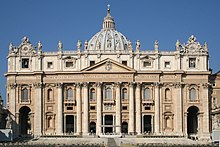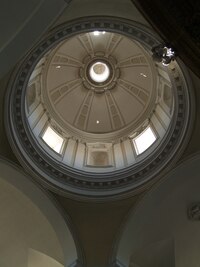Carlos Maderno
Carlo Maderno or Maderna (Capolago, Switzerland in 1556 - Rome, Italy on January 30, 1629), was an Italian architect remembered as one of the fathers of Baroque architecture, since its facades of Santa Susana, of the Basilica of San Pedro and of San Andrés della Valle, were of key importance in the evolution of the Italian Baroque.
Belonging to a family of stonemasons, he trained with his uncle Domenico Fontana, in Rome, as a stonemason and plasterer. His first important work was the façade of Santa Susanna, carried out between 1595 and 1603, in which he used the model of the façade of the church of the Gesù by Giacomo della Porta, although he introduced a larger volume that accentuated chiaroscuro.
Under the pontificate of Paul V, he won the competition for the completion of St. Peter's Basilica in the Vatican, in which he proposed, in order to give more space to the faithful, to transform Michelangelo's project from a centralized plan of a cross Greek in a longitudinal plant of Latin cross. Maderno's solution had to be a compromise that did not alter the fundamental concept proposed by Michelangelo, the dome, as the dominant element and organizer of space; when raising the monumental façade, he conceived it longitudinally and not in height, despite its great monumentality. Michelangelo's dome, in any case, was displaced towards the bottom, due to the new body introduced. The merit of having acted with great respect for the work of Michelangelo, and having articulated the building, with all the constraints that were posed to it, taking into account the space that preceded it and preparing the great urban solution given by Bernini for Saint Peter's Square.
Biography
Roman Beginnings
Training
Carlo Maderno was born around 1556 to Paolo and Caterina Fontana, sister of Domenico Fontana; he was the eldest of the four Pompeo brothers, Alessandro, Girolamo, Santino and his sister Marta. There are no documents on the year of birth (critics, however, agree to place it around 1556, a date also indicated by Pascoli and Baglione) or the place, which is supposed to have been Capolago (near Bissone, in the Ticino canton) since which was the place that Maderno himself, in the various notarial deeds, claimed to be his hometown.
Maderno began working in the marble quarries of the far north, but the few career opportunities offered by Capolago led him to move to Rome with four of his brothers to help his maternal uncle Domenico Fontana, considered at the time the most prestigious architect in the western world. It is not known exactly when he moved to Rome, where Fontana lived: some documents attest to his presence since the years of the pontificate of Pope Gregory XIII (1572-1585), as assistant to the construction works of San Luigi dei Francesi, directed precisely by Uncle Dominic. Always together with Fontana in various construction projects, he initially worked as a marble cutter, and his experience in sculptural crafts would help him quickly learn the rudiments of architecture: he, in fact, had substantially followed the same itinerary as the Ticinese masters — the Fontana, the Garvo, the Novi, the Castello, the Longhi, the Mola— who arrived in the city, invested their own capital to organize their own work, establishing companies or societies, thus favoring the rise from the humble "garzoni" to the prestigious role of the "capomaestri" ("construction masters").
Early Roman works
Maderno also followed this economic-productive mechanism, partnering with Filippo Breccioli in a company dedicated to the transport and trade of construction materials; He also worked alongside Giovanni Fontana, his brother Pompeo, Marsilio Fontana, his uncle Domenico and Girolamo Garvo, imposing himself strongly on the Roman entrepreneurial scene.
After Sixtus V's accession to the papal throne, Maderno had already achieved a reputation strong enough to obtain Roman citizenship, along with his brothers who had meanwhile already established themselves in Rome. As part of the works managed by the Fontana workshop, Maderno was also entrusted with commissions of a purely technical nature, such as the transfer of the statues of the Dioscuri (Castor and Pollux) in the Quirinal square or the elevation of the Sistine obelisks in Santa Maria Maggiore (1588), in the Lateran (1587-1588), in Piazza del Popolo (1587-1589) and in the Vatican. He was involved in those years in hydraulic engineering works, both as an executive (together with Giovanni Fontana in the Loreto aqueduct) and as a consultant, providing advice and advice on the regulation of the Velino river and the prevention of Tiber floods.
After Fontana's final transfer to Naples, since he had fallen out of favor after the death of Sixtus V, Maderno took over the family business, further consolidating his fame. In 1603, his first architectural work, the façade of the Church of Santa Susana, considered by many to be the first complete example of Baroque architecture. This façade, whose central axis was accentuated by the gradual use of pilasters, semi-columns and columns towards the middle of the elevation, aroused the attention of Asdrubale Mattei, Marquis of Giove and Marquis of Rocca Sinibalda, who commissioned him to build the palazzo itself (the only work carried out entirely by Maderno) on a plot located on the corner of the current streets of Funari and Caetani. In 1602 he assumed the commissions of Giacomo Della Porta, who died that same year, and entered the service of Pope Clement VIII; for the Aldobrandini family, to which the pontiff belonged, he completed the villa Belvedere in Frascati, enlarged the palazzo later Doria-Pamphili on Via del Corso and always planned the family chapel in Santa Maria sopra Minerva in Rome.
The Foscari chapel in the Basilica of Santa Maria del Popolo dates back to this same period, after the purchase by Monsignor Tiberio Cerasi of the future capella Cerasi.
Artistic maturity
The factory of San Pedro
Maderno and Giovanni Fontana took over the commissions from Giacomo della Porta and also assumed the superintendence of the Fabbrica di San Pietro in July 1603. The Petrian basilica, in fact, was in a very heterogeneous state: if great As part of Michelangelo's projects, with the construction of the dome and a body with a central plan, a considerable part of the original nave was still standing, although in precarious conditions of conservation. For this reason, the old factory was dismantled and it was decided to change the prestigious Michelangelesque complex. A competition was then launched to which renowned architects were invited: Flaminio Ponzio, Giovanni Fontana, Maderno, Girolamo Rainaldi, Niccolò Branconio, Ottavio Turriani, Domenico Fontana, Giovanni Antonio Dosio and Lodovico Maderno. The winner was Maderno himself, who found himself responsible for "one of the most important but also most thankless tasks of seventeenth-century Roman construction... [because] everyone felt entitled to compare their work with Michelangelo's project; and if the benevolent critics recognized the merit of being able, in the given circumstances, to save as much as possible from the project of the 'divine', those ill-disposed reproached him for having engaged in such an unequal competition".
Maderno, in his San Pedro project, was forced to respond primarily to functional, pastoral, and theological needs. The architect, in fact, had to build a portico, a sacristy and a loggia for blessings (not foreseen in Michelangelo's initial project), and avoid leaving the previously covered space of the old paleo-Christian temple unused, without also forgetting to provide space enough for liturgical activities. Maderno also decided to complete the Vatican basilica by extending the eastern arm of the Michelangelesque building, with a longitudinal body in a "processional tunnel", and to create, from 1608, the imposing façade. This intervention is one of the most discussed and criticized works in the history of architecture: in fact, the extension of the basilica, reducible to a Latin cross, prevents a close view of the great dome, while the façade, without the bell towers provided for in the Maderno project and not carried out for structural problems, it draws attention due to the excessive width.
Last years
Following the interventions in San Pietro, to which Maderno's name is inextricably linked, the architect completed the choir and dome of San Giovanni dei Fiorentini (finishing a work already begun by Della Porta) and began the church of Santa Maria della Victoria. He was particularly active in the works of San Andrés della Valle, where he worked for the next twenty years, until his death; here he completed the nave and built the transept and choir, aided by the active collaboration of his nephew Francesco Borromini, who worked as a stone carver.
Maderno also engaged the young Borromini in other constructions, including the restoration of Santa Maria della Rotonda, in the unchosen design of the church of Sant'Ignazio di Loyola in Campo Marzio, and in the building of the Barberini palace, in which Gian Lorenzo Bernini also participated. The management of this last factory was entrusted to Maderno precisely because of his experience: here the now old architect executed the east façade, the first two levels of the loggia, the layout and decorations of the north wing and, in general, the general lines of the project.
Works
- 1598: funeral chapel of the Caetani family in the Basilica of Santa Pudenciana, initiated by Francesco da Volterra, finished by Maderno.
- 1598-1602: Church of San Giacomo in Augusta, Rome; initiated by Francesco da Volterra, finished by Maderno.
- 1602: Aldobrandini chapel in the church of Santa Maria sopra Minerva in Rome.
- 1602-1604: Aldobrandini villa in Frascati; started by Giacomo della Porta, finished by Maderno.
- 1593-1603: church of Santa Susana, in Rome, interior decoration and facade.
- 1598-1610: palazzo Lancelotti, in Frascati; initiated by Francesco da Volterra, finished by Maderno.
- 1598-1608: palazzo Mattei, in Rome.
- 1607-1620: Basilica of Saint Peter in Rome, nave and facade.
- 1608: Basilica of San Andrés della Valle, from 1608 onwards, the construction of the facade according to plans of Maderno, finished according to Kuppel in 1622.
- 1611-1614: altar of Santa Maria della Pace.
- 1613: Villa Mondragone in Frascati, from 1613 in collaboration with the architects Giovanni Vasanzio, Flaminio Ponzio, Girolamo Rainaldi and Giovanni Fontana.
- 1614: San Giovanni de'Fiorentini, octogonal dome of the cruise.
- 1615: Quirinal Palace, in Rome, enlargement, cover and garden, from 1615.
- 1623-1629: Pontifical Palace in Castel Gandolfo, with the help of his assistants Bartolomeo Breccioli and Domenico Castelli.
- 1625-1629: palazzo Barberini, in Rome, started in 1625, finished by Gian Lorenzo Bernini and Borromini.
- palazzo Doria Pamphili of Rome, extension of the original palace of Gabriele Valvassori, then very modified by Antonio Del Grande.
Contenido relacionado
World Trade Center (1973-2001)
John Huston
Claire Forlani







